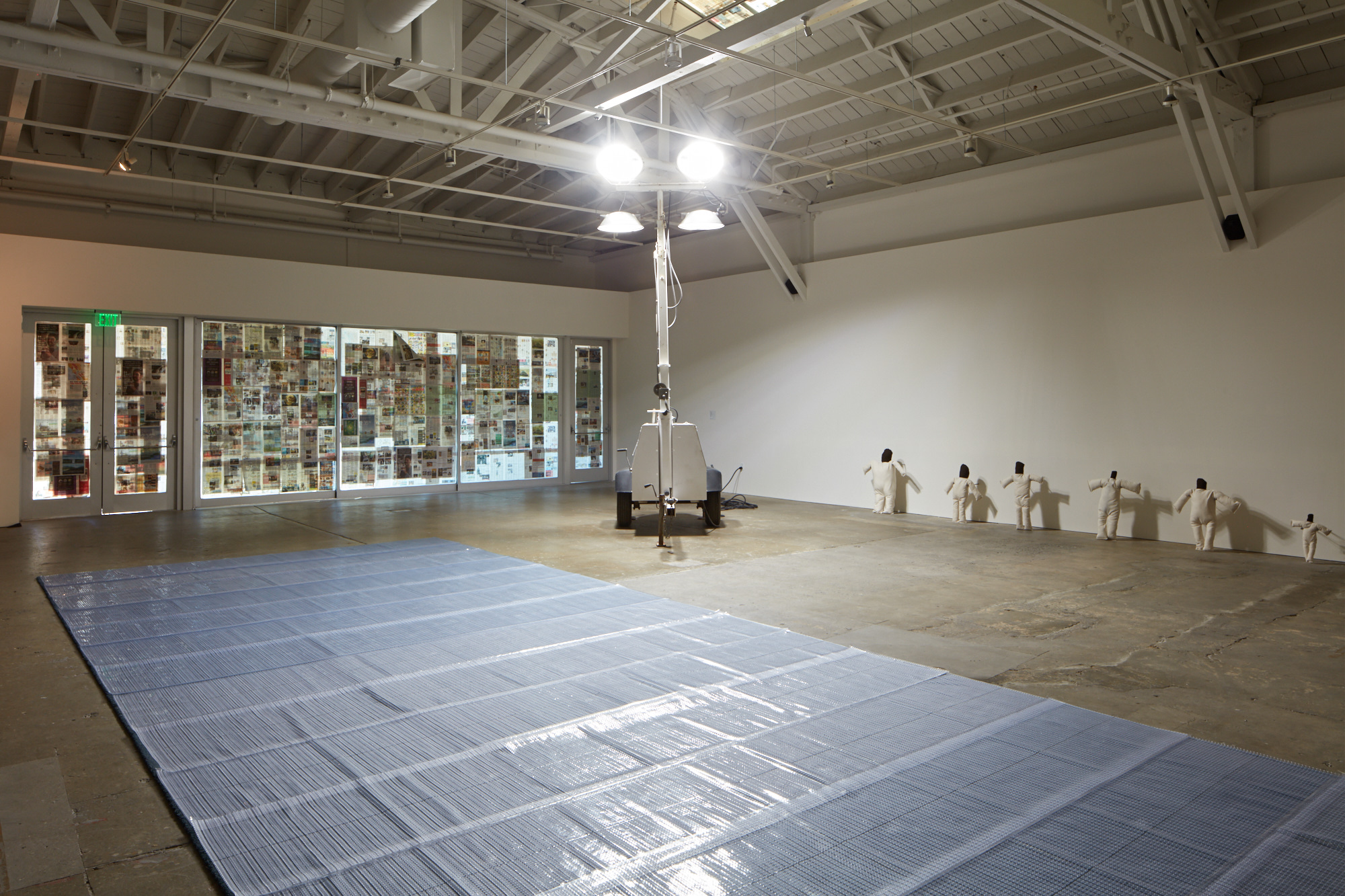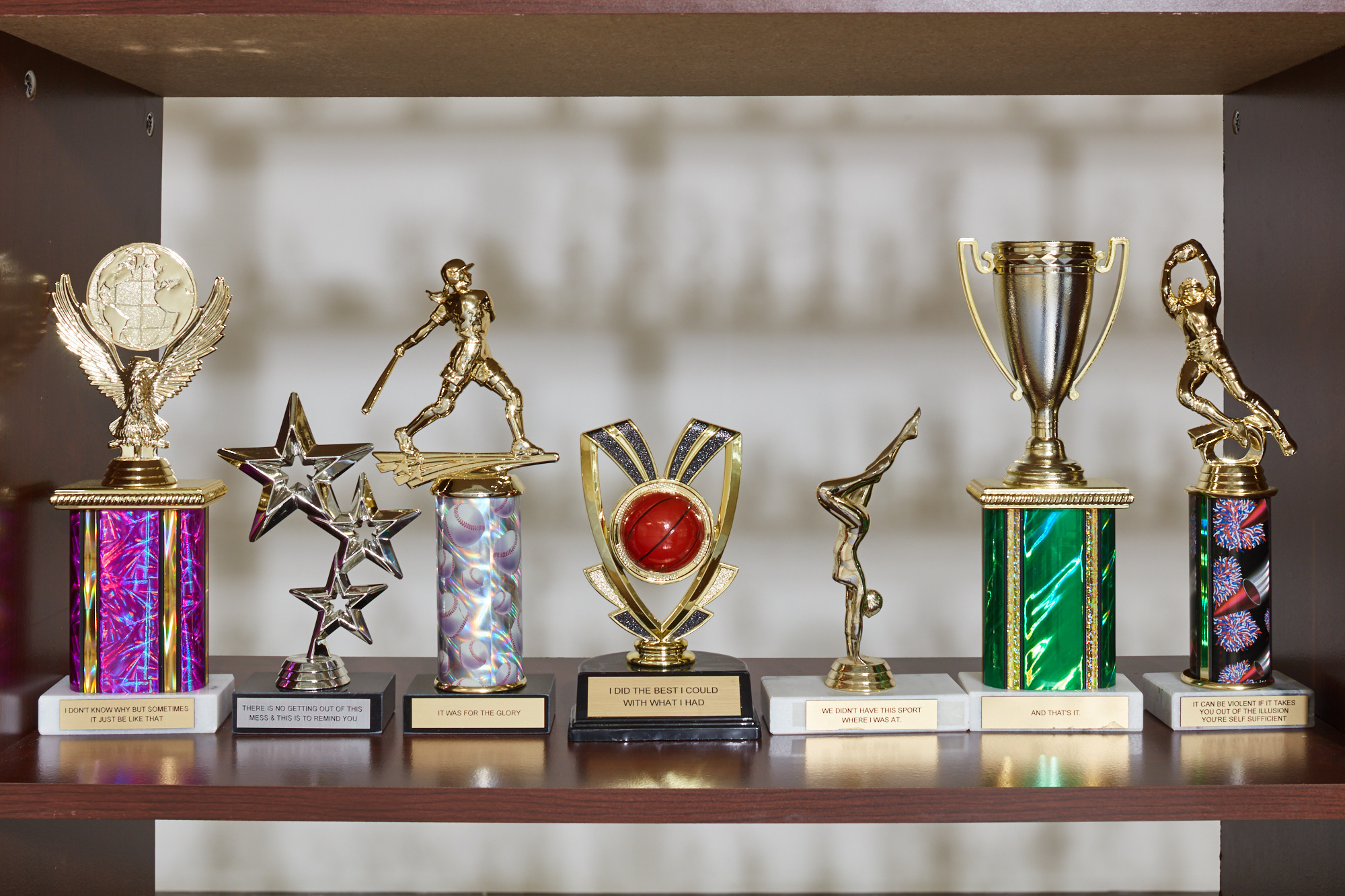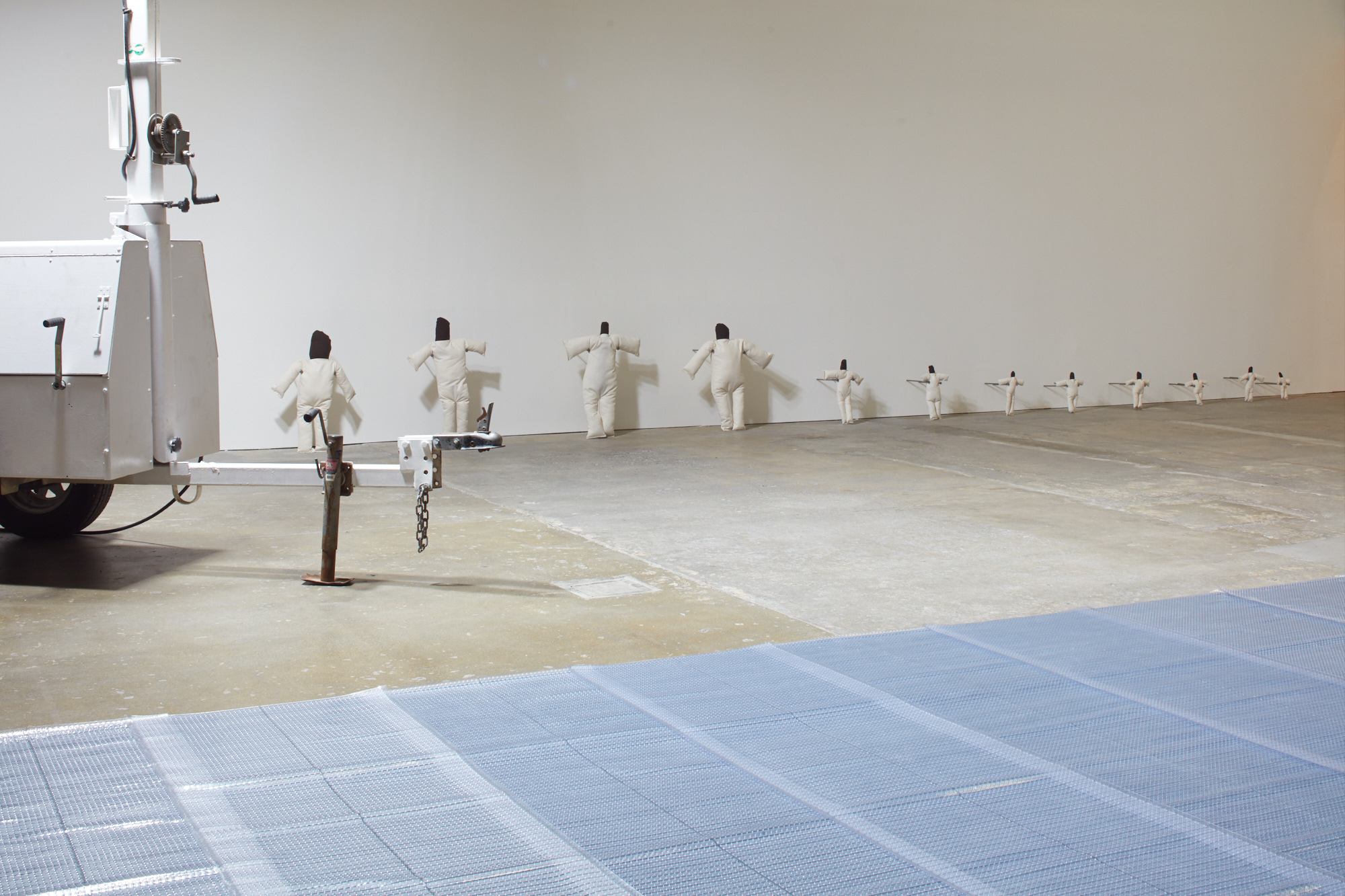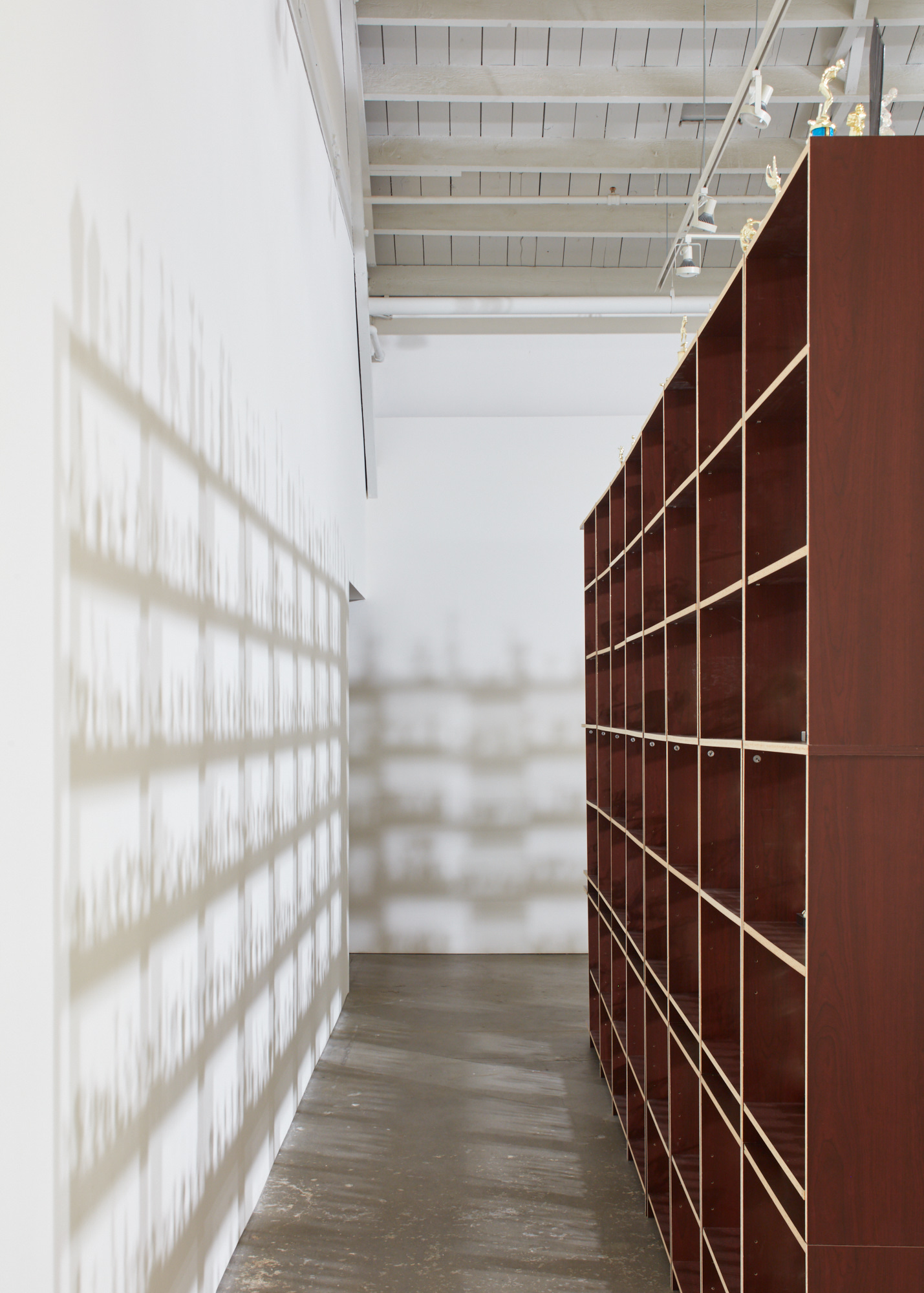THERE IS NO GETTING OUT OF THIS MESS & THIS IS TO REMIND YOU
Diamond Stingily Doing the Best I Can at CCA Wattis
By Camile Messerley
If you have walked up to the Wattis recently you might have asked yourself did I miss it? Is install still happening? The windows and skylights inside are covered with newspaper pages from floor to ceiling. When you step into this there is a necessary moment of adjustment that happens, first to the light. The newspaper blots out the illuminating and searing light of a converted Allmand Bros. light tower. The kind of light tower built to stay on until the work is done or when the sun comes up on a job site. Once my eyes adapted I found myself in a crowd of people looking into the exhibition Doing the Best I Can by artist and poet Diamond Stingily.
My eyes b-line first to the trophies playing catch with the light. Each of the trophies on display in the piece "In the middle but in the corner of 176th Place,” have a personalized plaque. To name a few…
THROUGH ALL THE MADNESS THIS ALL YOU GONE GET — IT CAN BE VIOLENT IF IT TAKES YOU OUT OF THE ILLUSION YOU’RE SELF SUFFICIENT — IT WAS FOR THE GLORY — THOSE WHO CAN & THOSE WHO CANNOT. THAT’S THE RACE. — I DID THE BEST I COULD WITH WHAT I HAD — YOU SHOULD BE GETTING YOURS BUT IT’S A DILEMMA WHEN YOU’RE CAUGHT UP— IT’S NOT ALL ABOUT THE WINNING, IT’S THE GIVING TOO
The inscriptions shuffle and repeat between statuettes. They bring to mind the bits of advice given to us from our coaches and teachers. The kinds of lessons we may need to hear over and over until they become muscle memory. Some are practical, some speak to accessibility and perhaps exclusion of access. As I walked along the back of the shelves I felt shrunk in the shadows, I felt a weight and pressure of being observed, of impressing expectations, and of being judged.
Coming back around and seeing the phrases repeat they swam about in my mind; I felt them roll across my tongue back and forth and I started to feel a calm resolve or acceptance in the words. There was a shift in the perspective and voice to a kind of “me to me” self-talk, the kind that you have with yourself in the mirror to grant yourself some relief and remember where you are at, have come, are going.
Directly in front of the bookcases were these long vinyl runners laid on top of a faded blue carpet flipped over to expose their sharp cleats. I crouched down next to the piece to see the frayed blue fringe of the edges peeking out from the vinyl mat. Is it an at-home practice pad? Is this the office of an acupressure physical therapist? Is the lining meant to support the carpet or me? Like all trophies, you cannot attain them without training, and so before you can reach the trophies here the piece “Flournoy and Kedzie” that gestures to stretching, endurance, training, and maybe healing. I imagined a gymnast stretching and somersaulting over the mat and when they land looking up to the bookcases holding nearly a thousand trophies that created an L around “Flournoy and Kedzie”. Painted on a wall in Knossos, Crete is one of the earliest depictions of a kind of gymnastics in art. The Toreador Fresco shows an individual practicing the ritual sport of bull-flipping. How does one train their potential and build a skill that you may only get to really try once in their life, doing them no earthly good but the build-up of faith. The individual participating would in preparation cinch their waists incredibly tight, and if my memory serves me this would lead them to kind of hallucination before testing their ability and fate.
Like all Wattis mailing list subscribers, leading up to the opening of the exhibition I received the show’s announcement, one of the lines that struck me, in particular, was “She used to bury her dolls in the backyard.” When I saw the piece “Hergott Shadows” and looked at the handmade faceless dolls all lined up and stood up I wondered why this note about Stingily burying her dolls when she was younger was important? Looking at the dolls they seem to be arranged from tallest to shortest, each of them made with a black face and a white body. Just like the shelves and trophies across from them, they cast a shadow of their own. The longer I look at the dolls I notice that there are really two groups of dolls, one that is taller than the others. Which brings me to this part in the audio-biographical-poetical-essay by Stingily that was shared in advance of the exhibition where she talks about being on a team with older girls’ whose duty she saw was to push the younger girls when they wanted to give up because they’ve never experienced the pain they volunteered for. Hergott or also God dolls are made by the Amish; they make these dolls faceless because they believed that everyone was the same. Without eyes, these dolls stared back and held my full attention, here, I came back to question my point of perspective as a viewer. Standing in the gallery room I remember someone once telling me that in dreams we can’t see faces, and I wondered if I was not standing in the delicate balance of dream— in this place your understanding of control and ability are in opposition with your hopes and fears.
Doing the Best I Can, is a show that is also about belonging to something outside of ourselves, but it’s also about what it means to step into that, into our best, what it means internally to hold that, but moreover, grow into that and apply in different parts of our lives.
Three days after the opening of Doing the Best I Can at The Wattis I was sitting alone on the corner barstool at Lovely’s watching the Clippers game with a very empty stomach and a dead phone. Earlier in the day, I was standing in line at Trader Joe’s when a woman sitting in a wheelchair next to the last check-out stand spoke out all of sudden and shared “I love sports, THANK GOD for the NFL and ESPN, I don’t know what I would do without sports”! A woman paying for her groceries next to her replied “I feel you, me either”, to which the woman in the wheelchair said, “And we don’t have to be ones trying, the one getting hurt, I can just watch them play”. Sports have always been a pastime for fans and a source of entertainment, but sports is also a metric of self-worth, validation, a livelihood of precarity not unlike living and working as an artist. These vocations make it easy to forget that we're human beings, not human doings.
As I continued to watch the Clippers game I remember why I stopped watching sports and why I never enjoyed watching them on television: I don’t like the narration, I don’t enjoy the statistics, and I really don’t care for instant replays. There is a circus of distractions built up around the athletes which make us forget the athletes. The last time I enjoyed watching sports was as a devout 5th grade fan standing on the sidelines of my cousin’s high school football games. My cousins and their teammates were playing for a future with 0 guarantees of anything but a concussion or a fractured disk. My mother always compared this kind of commitment to that of a gladiator’s fight for their life. Risking the trauma to potentially gain a sense of belonging to something greater than yourself. In this too I think there is also the hope of coming to know a better version of yourself situated alongside others in a similar lane, to know what is and can be your best.
The exhibition is on view at The Wattis Institute through April 6, 2019.
IMAGES: Diamond Stingily, Doing the Best I Can, 2019; installation view, Wattis Institute; Courtesy of the artist; Queer Thoughts, New York; and Ramiken, New York; Photo: Johnna Arnold
NOTE: The name of this piece is borrowed from the piece "In the middle but in the corner of 176th Place"




